Logitech M570 Wireless Trackball Review
The company Logitech, well-known for its good keyboards and mice, a few months ago released a curious gadget - the M570 wireless trackball. Since I have long been interested in various ergonomic manipulators, I eagerly waited for the appearance of new items in Russian retail.

My patience did not last long, and I, gathering my courage, ordered the coveted gadget on eBay. The order cost me $ 83.90 ($ 64.70 plus $ 19.20 for shipping from Hong Kong), and I received my New Year gift 20 days after the payment. Today I want to present my review of this device to the distinguished community.
Packaging Logitech M570 is standard for all products of the company and is a small cardboard box with a plastic window through which you can see the manipulator and a tiny receiver-dongle.
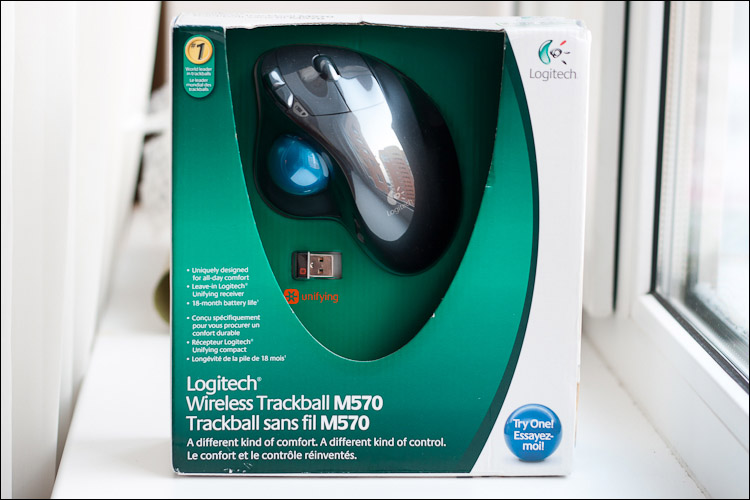
To my surprise, in addition to the trackball and the receiver, only a bag with a guarantee memo and paper instructions in several languages was found (naturally, there was no Russian among them).

The eminent manufacturer for some reason decided that the M570 buyers did not deserve either a carrying case, or even a driver disk. Well, okay, let's deal with this somehow later, and now is the time to start exploring the contents of the box.
If someone does not know, modern trackballs in their design are “the ball-up mouse”, that is, their body is a bed for the palm, and the cursor moves by means of a ball that can be twisted with fingers or palm.

Designers at Logitech did not invent a bicycle and continued the tradition of the Trackman device line , which is quite popular in the West. Like its wired “ancestors,” the M570 looks like a good, ergonomic mouse, on its left side which has magically grown a brilliant blue rounder that can be rotated with your thumb.

With the exception of the ball, all other controls are traditionally “mouse” - a gentleman's set of four buttons (left, right, “forward”, “back”) and a pressed scroll wheel are at the user's disposal.
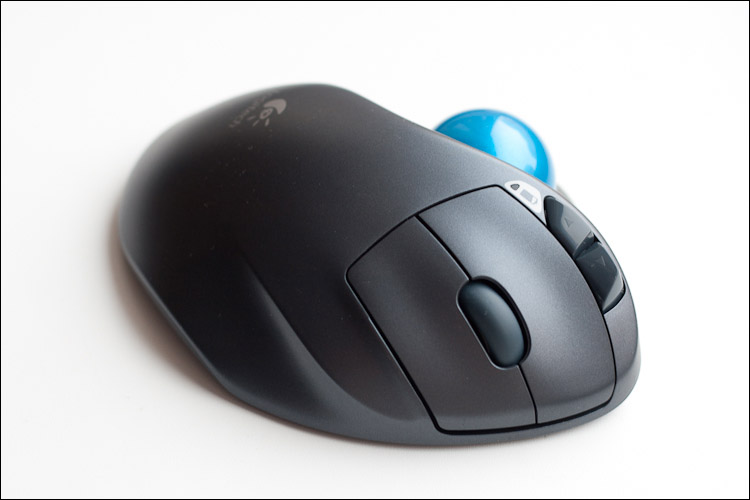
The indicator with the battery icon, located next to the left button, displays the wireless nature of the manipulator - when the M570 “wakes up” after a long inactivity, the indicator lights up green, and when the battery runs out, it turns red.
The case of the device is made of reliable, but dull gray matte plastic, which does not look so elegant as on the official photos from Logitech.

The ball, apparently, is also made of plastic, but bright blue and defiantly brilliant.
On the underside of the trackball, you can find four rubber pads that prevent sliding on the working surface (you will probably try to move it around the table first), the battery cover, the power switch, and the mysterious opening through which the ball itself is visible.

Opening a small hatch, we notice one finger-type battery, which the caring guys from Logitech have already put, as well as a small slot in which you can put the receiver so that it does not get lost when transporting the manipulator.

By the way, about the receiver - it is so small that, being connected to the USB port, it stands only a couple of millimeters and does not interfere at all when carrying the laptop.

“Baby” is not as simple as it seems - it supports proprietary Unifying technology, which provides simultaneous operation of up to six wireless devices through a single receiver.

Finally, a quick inspection is over, it's time to try the Logitech M570 in action. When we turn on the trackball, we insert the receiver into a free USB port, and within a few seconds we hear a familiar sound, indicating that Windows 7 recognized a standard mouse in the new device.
It was surprisingly comfortable to use the manipulator - the hand lay on its body like a glove (which is quite expected, because the guys from Logitech had been refining the ergonomics of their products for many years). The thumb was exactly above the ball, and the rest of the fingers were placed comfortably in special recesses. The overall dimensions of the case to me, as the owner of a small palm, quite fit.
')
Since I have already gone through the entire English-language Internet on the subject of trackballs, I did not have a desire to make a manipulator on the table. True, I couldn’t particularly boast the accuracy of the positioning with the cursor either - it wasn’t always possible to get into the interface buttons of the native operating system the first time. Having a little accustomed, I ventured to launch Quake 3, which had long been dusting without work on the hard disk. In battle, the trackball proved to be far from the best - even on the easiest level of difficulty, bots carried me out as a child.
It is worth mentioning one particular feature of the use of this type of manipulators - inertia of the ball. The fact is that on a high sensitivity (or at a high cursor speed set in the OS settings) the trackball cannot provide high positioning accuracy, and at low sensitivity you have to wield too much with your thumb. And here comes a simple and intuitively accessible principle to help - spin the ball harder so that it is spinning by inertia for some time, and at that moment, when the cursor reaches the desired area, “intercept” it and bring it to the desired button or links. Having adapted to this method, after a couple of days of using the M570, I began to hit all the interface elements without a miss in fractions of a second, and the cursor was exactly in the same place on the screen where I wanted. Owners of huge monitors or those who are accustomed to a little sensitivity will especially appreciate this trackball chip.
Having dealt with the unusual principle of control, I began to draw attention to how the trackball buttons work. And if there were no surprises from the left and right (they were pressed with the usual effort, while publishing quite standard quiet clicks), then the additional buttons “back” and “forward” ... uh ... well, they were also well pressed, however, to get they turned out to be very difficult. Their location suggests that I will press them with the index finger, that in practice this turned out to be a very inconvenient operation - you had to pull the whole brush to get to them.
With the middle wheel button, the engineers at Logitech didn’t have anything either - it is very flimsy, it rotates with an opposing crunch, and it is also pressed with excessive force. By the way, I did not understand why a new-fashioned wheel with two scrolling modes, which is present in many company mice, was not put on the device. Apparently, the trackball got such a simple scroller solely for reasons of economy.
The manipulator communicates with the computer via a proprietary Logitech® Advanced 2.4 GHz wireless protocol. Strangely enough, there is nothing much to tell about him - there were no failures or delays when working with the “rodent”.
But the autonomous operation of the device is worth mentioning separately - if you believe the official site of Logitech, the M570 can last up to one and a half years from a single finger battery. I hope to find out how this statement is true, I can, at least in 2012 (emoticon). By the way, the energy saving functions work perfectly - when idle, the trackball “falls asleep” (I did not manage to detect the time needed for this), and when it starts, it turns on in a split second.
But the brand M570 drivers really surprised me. The mouse from Logitech, which I used to use, was packaged with monstrous multi-megabyte software, except that it didn’t record the disks and did not prepare an espresso. Sad memories were dispelled by the latest SetPoint version 6.20, which has a sea of really useful features, but weighs less than 35 megabytes after installation. Here are some of its features:
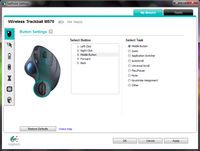
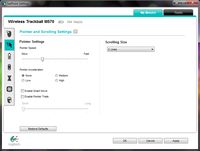
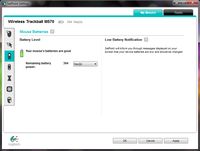
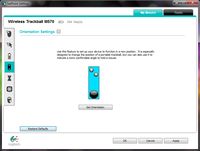
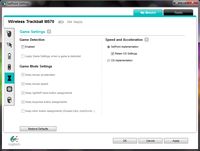
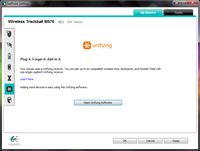
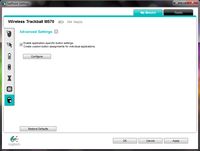



It so happened that the writing of this review was delayed and only now, after a month of active use, can I tell you about the pitfalls of a new product from Logitech.
As it turned out, not the most successful implementation of the middle button does not affect the comfort of using the device at all - everything is spinning, pressed and performs its functions well. I don’t use additional buttons due to their inconvenient location (thanks to Opera browser forour happy childhood gesture control). There are also no complaints on the manipulator radio path - everything works as intended.
To my surprise, problems (more precisely, minor troubles) began to be observed near the ball itself - it turned out that the three slippery bumps on which it rests and due to which it rotates tend to clog, which is why all operations with the ball begin to require effort. Yes, the manipulator will have to be periodically cleaned, as in the good old days. However, this does not cause any special troubles - the round bar is pulled out without any problems, if you press it with your finger through the hole at the bottom of the trackball, and the “spikes” on which the ball rests are easily cleaned with a cotton swab or, at worst, with a fingernail.
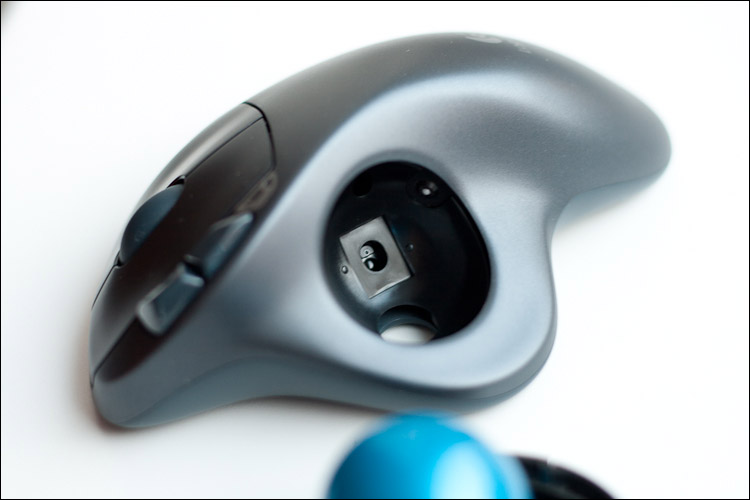
In order for everyone to decide for themselves the usefulness of such a device on the farm, I will list all its strengths and weaknesses. Just in case, I’ll clarify that they all relate not to trackballs in general, but to a specific Logitech M570 model.
+ convenient form
+ long battery life
+ functional software
- non-trustworthy scroll button
- bad location of additional keys
- only fit right handed
At the end of the review, I would like to say that, in general, my acquaintance with the world of trackballs turned out to be very pleasant, and, moreover, I wanted to order another M570 for my job, where SteelSeries Ikari Laser is working in the sweatof the tail.
Using the trackball, I kill two birds with one stone - on the one hand, there is a lot of free space on the table (now there are no carpets and wires), and on the other, I don’t worry about the tunnel syndrome , which began to bother me after a long work with normal ( albeit ergonomic) mouse.
As a bonus, I attach a family photo of the Logitech M570 to the company with SteelSeries Ikari Laser - in my opinion, one of the most convenient mouse manipulators for right-handers.

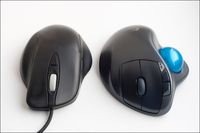
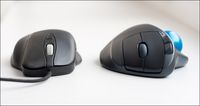
More manipulators, good and different!
PS My desktop asked me to say hello to Bumburum.
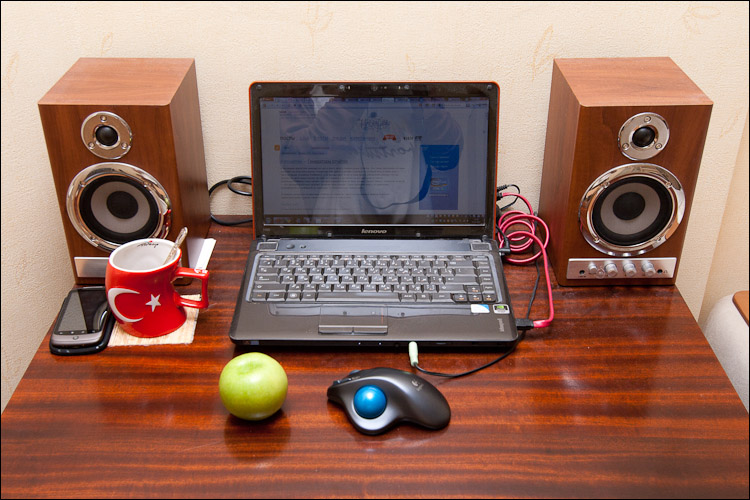

My patience did not last long, and I, gathering my courage, ordered the coveted gadget on eBay. The order cost me $ 83.90 ($ 64.70 plus $ 19.20 for shipping from Hong Kong), and I received my New Year gift 20 days after the payment. Today I want to present my review of this device to the distinguished community.
Acquaintance
Packaging Logitech M570 is standard for all products of the company and is a small cardboard box with a plastic window through which you can see the manipulator and a tiny receiver-dongle.

To my surprise, in addition to the trackball and the receiver, only a bag with a guarantee memo and paper instructions in several languages was found (naturally, there was no Russian among them).

The eminent manufacturer for some reason decided that the M570 buyers did not deserve either a carrying case, or even a driver disk. Well, okay, let's deal with this somehow later, and now is the time to start exploring the contents of the box.
Appearance
If someone does not know, modern trackballs in their design are “the ball-up mouse”, that is, their body is a bed for the palm, and the cursor moves by means of a ball that can be twisted with fingers or palm.

Designers at Logitech did not invent a bicycle and continued the tradition of the Trackman device line , which is quite popular in the West. Like its wired “ancestors,” the M570 looks like a good, ergonomic mouse, on its left side which has magically grown a brilliant blue rounder that can be rotated with your thumb.

With the exception of the ball, all other controls are traditionally “mouse” - a gentleman's set of four buttons (left, right, “forward”, “back”) and a pressed scroll wheel are at the user's disposal.

The indicator with the battery icon, located next to the left button, displays the wireless nature of the manipulator - when the M570 “wakes up” after a long inactivity, the indicator lights up green, and when the battery runs out, it turns red.
The case of the device is made of reliable, but dull gray matte plastic, which does not look so elegant as on the official photos from Logitech.

The ball, apparently, is also made of plastic, but bright blue and defiantly brilliant.
On the underside of the trackball, you can find four rubber pads that prevent sliding on the working surface (you will probably try to move it around the table first), the battery cover, the power switch, and the mysterious opening through which the ball itself is visible.

Opening a small hatch, we notice one finger-type battery, which the caring guys from Logitech have already put, as well as a small slot in which you can put the receiver so that it does not get lost when transporting the manipulator.

By the way, about the receiver - it is so small that, being connected to the USB port, it stands only a couple of millimeters and does not interfere at all when carrying the laptop.

“Baby” is not as simple as it seems - it supports proprietary Unifying technology, which provides simultaneous operation of up to six wireless devices through a single receiver.

The convenience of use
Finally, a quick inspection is over, it's time to try the Logitech M570 in action. When we turn on the trackball, we insert the receiver into a free USB port, and within a few seconds we hear a familiar sound, indicating that Windows 7 recognized a standard mouse in the new device.
It was surprisingly comfortable to use the manipulator - the hand lay on its body like a glove (which is quite expected, because the guys from Logitech had been refining the ergonomics of their products for many years). The thumb was exactly above the ball, and the rest of the fingers were placed comfortably in special recesses. The overall dimensions of the case to me, as the owner of a small palm, quite fit.
')
Since I have already gone through the entire English-language Internet on the subject of trackballs, I did not have a desire to make a manipulator on the table. True, I couldn’t particularly boast the accuracy of the positioning with the cursor either - it wasn’t always possible to get into the interface buttons of the native operating system the first time. Having a little accustomed, I ventured to launch Quake 3, which had long been dusting without work on the hard disk. In battle, the trackball proved to be far from the best - even on the easiest level of difficulty, bots carried me out as a child.
It is worth mentioning one particular feature of the use of this type of manipulators - inertia of the ball. The fact is that on a high sensitivity (or at a high cursor speed set in the OS settings) the trackball cannot provide high positioning accuracy, and at low sensitivity you have to wield too much with your thumb. And here comes a simple and intuitively accessible principle to help - spin the ball harder so that it is spinning by inertia for some time, and at that moment, when the cursor reaches the desired area, “intercept” it and bring it to the desired button or links. Having adapted to this method, after a couple of days of using the M570, I began to hit all the interface elements without a miss in fractions of a second, and the cursor was exactly in the same place on the screen where I wanted. Owners of huge monitors or those who are accustomed to a little sensitivity will especially appreciate this trackball chip.
Having dealt with the unusual principle of control, I began to draw attention to how the trackball buttons work. And if there were no surprises from the left and right (they were pressed with the usual effort, while publishing quite standard quiet clicks), then the additional buttons “back” and “forward” ... uh ... well, they were also well pressed, however, to get they turned out to be very difficult. Their location suggests that I will press them with the index finger, that in practice this turned out to be a very inconvenient operation - you had to pull the whole brush to get to them.
With the middle wheel button, the engineers at Logitech didn’t have anything either - it is very flimsy, it rotates with an opposing crunch, and it is also pressed with excessive force. By the way, I did not understand why a new-fashioned wheel with two scrolling modes, which is present in many company mice, was not put on the device. Apparently, the trackball got such a simple scroller solely for reasons of economy.
PC connectivity and battery life
The manipulator communicates with the computer via a proprietary Logitech® Advanced 2.4 GHz wireless protocol. Strangely enough, there is nothing much to tell about him - there were no failures or delays when working with the “rodent”.
But the autonomous operation of the device is worth mentioning separately - if you believe the official site of Logitech, the M570 can last up to one and a half years from a single finger battery. I hope to find out how this statement is true, I can, at least in 2012 (emoticon). By the way, the energy saving functions work perfectly - when idle, the trackball “falls asleep” (I did not manage to detect the time needed for this), and when it starts, it turns on in a split second.
Firmware
But the brand M570 drivers really surprised me. The mouse from Logitech, which I used to use, was packaged with monstrous multi-megabyte software, except that it didn’t record the disks and did not prepare an espresso. Sad memories were dispelled by the latest SetPoint version 6.20, which has a sea of really useful features, but weighs less than 35 megabytes after installation. Here are some of its features:
- Display of battery status in days or percentages (several devices working from one Unifying receiver are supported), as well as displaying a low battery warning
- Connect and disconnect wireless devices to this Unifying receiver
- Calibration of the orientation of the ball (this means that you can adjust in which direction you need to turn the ball so that the operating system understands this as “Up”)
- Assigning functions to all buttons and scroll wheel
- Change settings for acceleration and scrolling speed (separately for different applications, separately for games)










Conclusion
It so happened that the writing of this review was delayed and only now, after a month of active use, can I tell you about the pitfalls of a new product from Logitech.
As it turned out, not the most successful implementation of the middle button does not affect the comfort of using the device at all - everything is spinning, pressed and performs its functions well. I don’t use additional buttons due to their inconvenient location (thanks to Opera browser for
To my surprise, problems (more precisely, minor troubles) began to be observed near the ball itself - it turned out that the three slippery bumps on which it rests and due to which it rotates tend to clog, which is why all operations with the ball begin to require effort. Yes, the manipulator will have to be periodically cleaned, as in the good old days. However, this does not cause any special troubles - the round bar is pulled out without any problems, if you press it with your finger through the hole at the bottom of the trackball, and the “spikes” on which the ball rests are easily cleaned with a cotton swab or, at worst, with a fingernail.

In order for everyone to decide for themselves the usefulness of such a device on the farm, I will list all its strengths and weaknesses. Just in case, I’ll clarify that they all relate not to trackballs in general, but to a specific Logitech M570 model.
+ convenient form
+ long battery life
+ functional software
- non-trustworthy scroll button
- bad location of additional keys
- only fit right handed
At the end of the review, I would like to say that, in general, my acquaintance with the world of trackballs turned out to be very pleasant, and, moreover, I wanted to order another M570 for my job, where SteelSeries Ikari Laser is working in the sweat
Using the trackball, I kill two birds with one stone - on the one hand, there is a lot of free space on the table (now there are no carpets and wires), and on the other, I don’t worry about the tunnel syndrome , which began to bother me after a long work with normal ( albeit ergonomic) mouse.
As a bonus, I attach a family photo of the Logitech M570 to the company with SteelSeries Ikari Laser - in my opinion, one of the most convenient mouse manipulators for right-handers.



More manipulators, good and different!
PS My desktop asked me to say hello to Bumburum.

Source: https://habr.com/ru/post/114192/
All Articles